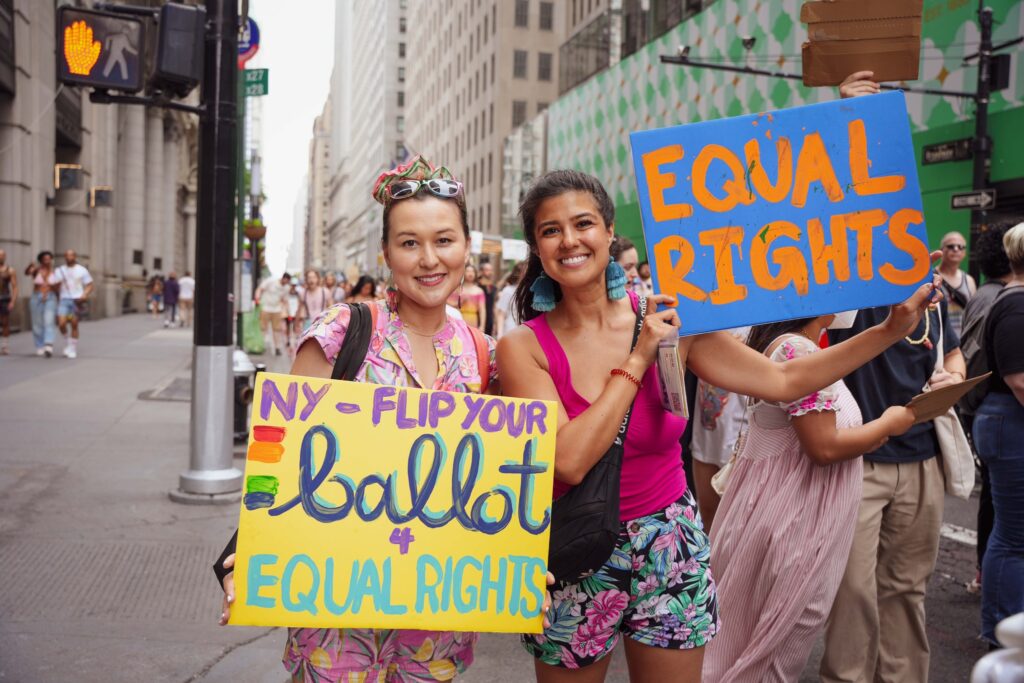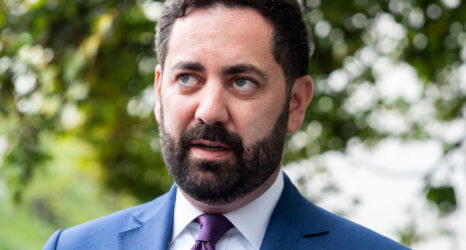“We have to set the path for other states to pursue equality and provide the strongest possible protections in their constitutions,” Sasha N. Ahuja, campaign director of New Yorkers for Equal Rights, told Ms.

Update: A New York ballot measure to create constitutional protections for abortion and create explicit protections for people who experience discrimination, passed overwhelmingly on Tuesday.
Come Nov. 5 (or earlier), voters in New York state will have the chance to weigh in on Proposal 1, the first U.S. constitutional amendment of its kind, which will establish comprehensive safeguards against discrimination and explicitly protect reproductive rights, including the right to abortion for state residents.
According to New Yorkers for Equal Rights (NYER), a broad coalition of more than 300 diverse groups that support the initiative, the effort is different from other equal rights amendments because it includes protections for reproductive rights. This is necessary because, despite New York’s reputation as a liberal stronghold, 53 anti-reproductive rights bills were introduced in its legislature over the last decade, NYER says. And in 2022, an antiabortion candidate came close to winning the governor’s race.
While these efforts failed, NYER asserts that rights not explicitly outlined in the state Constitution can be taken away, opening the door to new barriers to access if the political winds blow further rightward.
NYER campaign director Sasha N. Ahuja spoke to Ms. reporter Eleanor J. Bader two months before Election Day.
We’re working incredibly hard to educate voters that a YES vote means they are voting to protect abortion and reproductive freedom.
Sasha N. Ahuja
“I can’t stress enough how important this fight is here in New York and in the rest of the country,” she said. “The Dobbs decision told us that we need to affirm our rights in every state and restore access in places where it has been curtailed.”
Eleanor J. Bader: Proposal 1, the New York Equal Rights Amendment, bars discrimination based on age, disability, ethnicity, national origin, race, sex, sexual orientation and gender. It also prohibits discrimination based on pregnancy status and outcome, embedding the right to comprehensive reproductive healthcare into the state Constitution. It will prevent the prosecution of miscarriages and stillbirths, tragedies that have been criminalized in several places.
Tell me about the process of getting the measure on the November ballot.
Sasha Ahuja: There are several steps to passing a constitutional amendment in New York. The first requires the measure to succeed in two legislative sessions. The State Assembly and State Senate initially passed the initiative in July 2022 and passed it again in January 2023. It now goes before voters and needs a simple majority to become part of our Constitution.
We started the process of getting the amendment on the ballot early, about a year ago before there was a lot of attention on the 2024 election. Eleven organizations developed the initial strategy to forge a path to equality for all. These groups included unions, groups supporting and providing reproductive healthcare and advocates for LGBTQ+, immigrant and civil liberties. They helped us fundraise and build a coalition that now has more than 300 partners. Basically, we’re working with everyone who is involved in nonpartisan organizing across the state.
Right now, a lot of folks are learning about Proposal 1 for the first time. Throughout the state, people are tuning into the top of the ticket and looking into the many other races up and down the line. The proposition is the first initiative they’ll see on their ballots. We have more than 50 events scheduled over the next few weeks to educate voters about the amendment’s significance. We’re canvassing, doing phone banks, knocking on doors and tabling at community events and meeting places, like farmer’s markets, in every part of the state.
Bader: The language of Proposal 1 is clunky. How did the phrasing come about?
Ahuja: New York state requires the Board of Elections to make ballot measures accessible to readers at an 8th grade literacy level, meaning that the language is supposed to be direct and easily understood. Voters should be able to read it and understand that they are supporting abortion.
We know that the measure is written in a way that means the proposal will not be clear to everyone. This is why we’re working incredibly hard to educate voters that a YES vote means they are voting to protect abortion and reproductive freedom. They need to know that it means they are voting to ensure no New Yorker is discriminated against for any reason: age, disability, race, gender, sexual orientation, ethnicity or because they had an abortion.
I can’t speak for the Board of Elections, but I know that the language used for ballot measures is often contentious. This increases the challenge for us, but we are working to make sure that every voter knows that this amendment is necessary to protect abortion rights.
Bader: Proposal 1 is the first equal rights amendment to ensure that the right to have an abortion is guaranteed in a state constitution. How will this impact other states?
Ahuja: In 2022, when the Supreme Court handed down the Dobbs decision, the abortion fight literally came to our doorstep. When Proposal 1 passes in November, other states will look to replicate our effort. Already, equality measures to protect abortion are being discussed for 2026 in Nevada and Oregon. We have to set the path for other states to pursue equality and provide the strongest possible protections in their constitutions.
This is essential. Of course, implementation is key. Because of Dobbs, we are rethinking how to use equality amendments more generally. Already, Nevada and Pennsylvania have used their state Equal Rights Amendments to eliminate the Hyde Amendment and assure that all people have access to abortion. This is critically important.
Bader: Right-wing opponents of Proposal 1 tried to get it removed from the ballot. Since that effort failed, the conservative Coalition to Protect Children, the state GOP, the Catholic Archdiocese and a slew of antiabortion groups have mobilized. Their messaging asserts that the amendment is a “parent replacement act” that will usurp their rights. How is NYER countering this distortion?
Ahuja: The opposition is spreading lies in an attempt to divide and distract us. This forces the campaign to increase our efforts to make sure voters understand that Proposal 1 is about protecting abortion and guaranteeing the freedom to live without discrimination.
But I want to emphasize that Proposal 1 changes nothing when it comes to making decisions about our children. State law requires young people under the age of 18 to get parental consent for gender-affirming healthcare. The amendment does not affect this.
Bader: Five years ago, in 2019, New York state finally removed abortion from its homicide code. Although the statute had not been enforced for decades, the possibility of a nationwide abortion ban continues to threaten us. What happens to state constitutional protections should the unthinkable happen and a ban gets enacted?
Ahuja: Federal law overrides state law so state protections would not hold. This is why everyone needs to do everything they can to make sure this does not happen—the fight to protect our rights happens at the federal, state and local levels. But people everywhere get it. They understand that the fight for reproductive freedom is their fight. This is true for immigrant rights organizations, older adults, people with disabilities, LGBTQ+ folks, unions. …
People in every corner of the country are speaking about reproductive justice and autonomy. They recognize that no one should be discriminated against because of who they are or what they choose to do when they become pregnant.
Bader: New York state has relatively robust protections for abortion access, including Medicaid funding. In addition, there are few restrictions on providers or patients. I’ve heard many people question the necessity of the amendment since abortion is not in danger. How is NYER working to undermine this complacency?
Ahuja: Yes, people tend to be complacent when there is no imminent threat, but we need to learn from the past. In the 2022 governor’s race, we saw a quarter million New York City voters stay home; our base didn’t really turn out. A year earlier in 2021, we had voting rights measures on the ballot that unfortunately failed because 30 percent of New York City voters left the question blank.
We learned from these failures which is why, in 2024, voter engagement is not being taken for granted. People are fired up, ready to work and talk to folks all over the state. Precedent is also on our side. Abortion ballot measures have won every time they’ve gone directly before voters, but it is super important for everyone to get involved. There are phone banks every night of the week. This is not a time to sit on the sidelines.
At Ms. magazine, our mission is to deliver facts about the feminist movement (and those who stand in its way) and foster informed discussions—not to tell you who to vote for or what to think. We believe in empowering our readers to form their own opinions based on reliable reporting. To continue providing you with independent feminist journalism, we rely on the generous support of our readers. Please consider making a tax-deductible donation today if you value the work we do and want to see it continue. Thank you for supporting women’s voices and rights.
Up next:






